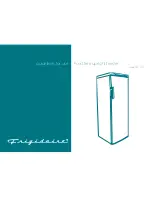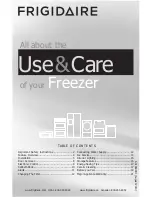
9
set, the lower the temperature becomes. A medium setting is the most suitable for general
operation. The freezer's temperature will vary depending on the quantity of foods stored and
the frequency of the door opening. In order to maintain good cooling efficiency and save
energy, we recommend that you do not overfill the freezer or open the door too frequently.
CAUTION: To prevent damage, do not attempt to turn the thermostat clockwise beyond the
3
position.
Cleaning and Maintenance
1. Defrosting
The freezer must be manually defrosted. This should be done when frost is more than ¼”
(5mm) thick.
a. Power off the freezer, open the door and remove all food to a cool place.
b. Remove the freezer drawers.
c. Remove ice and frost, or let it melt naturally. Do not use an electric heater.
d. Clean up the remaining water with a clean soft cloth.
e. Put the drawers and food back inside the freezer. Power on again.
NOTE: If you want to speed up the defrosting process, put a bowl of hot water inside the
cabinet and close the door.
CAUTION:
Never use sharp or metallic instruments (e.g. knives) to remove frost/ice from
the evaporator as this will damage the evaporator. A punctured evaporator will cause
serious problems.
2. Cleaning
The inside of the freezer should be cleaned often.
a. Power off the appliance
b. Use a soft towel with water or mild, non-abrasive cleanser to scrub away any food
residue.
c. Wipe with a soft, dry cloth.
NOTE: Do not pour water onto the outer walls of the freezer, since this will affect the
insulation. Do not use hot water, acid, alkali, gasoline, benzene, caustic cleanser,
alcohol, or hard brushes to clean the plastic parts.
3. Turning off the unit
































